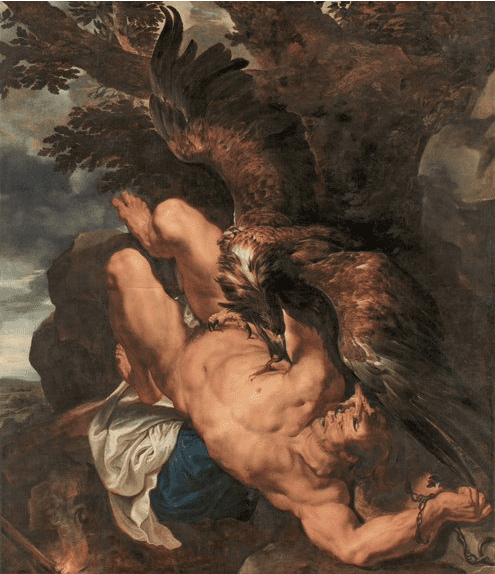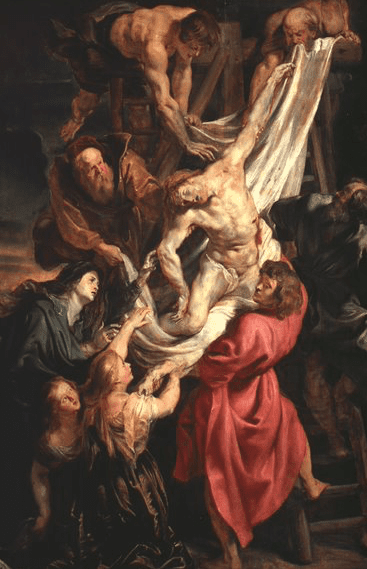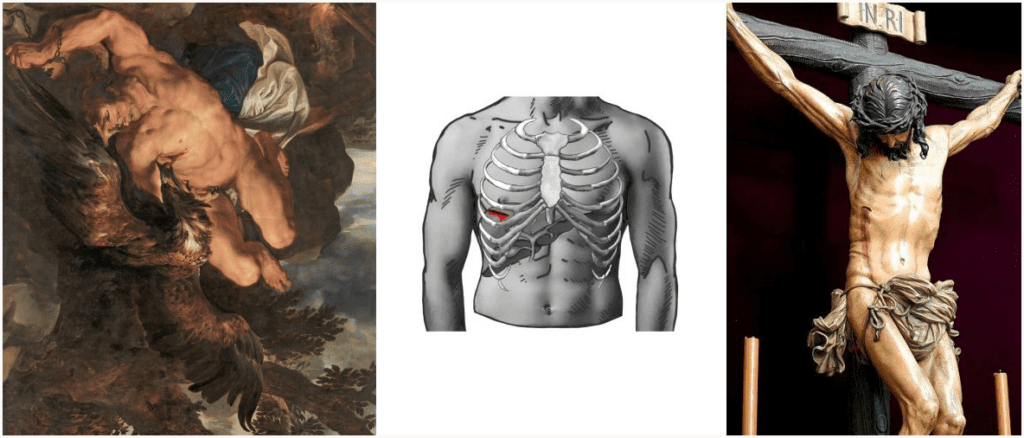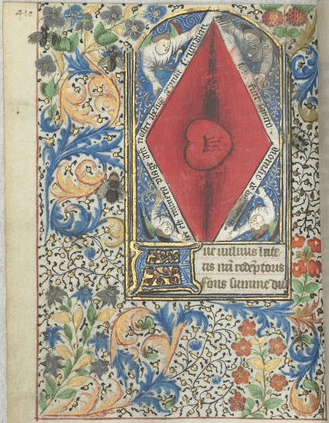Julia van Rosmalen
Thomas van Gulik
Amsterdam, Netherlands

The myth of Prometheus has been a source of inspiration for many visual artists over the centuries. Prometheus, a Titan, was punished by the supreme god Zeus for giving to mankind the Olympic fire, with which they learned to think and feel. He was chained to a cliff in the Caucasus, where he was visited daily by an eagle who ate part of his liver through a wound in the right side of his chest. At night, his liver would grow back, perpetuating his punishment through eternity.
It is not hard to see how Prometheus and Christ might register as thematically similar. Both made selfless and personal sacrifices for the benefit of humanity, actions coupled with intense bodily suffering. The emotive and lasting power of these figures and their stories helps to explain their continued presence in art. This presence is especially visible in the Baroque period, an era and style characterized by a particular fascination with the natural body, paired with a fondness for depicting drama and pathos. Bodily suffering, as in that of Christ and Prometheus, aptly combines these two criteria. Both the passion of Christ and the punishment of Prometheus are subject matters that allow for this sought-after combination of anatomy and pathos.1
The visual correspondence between Prometheus and Christ is well illustrated in the work of Peter Paul Rubens. When we compare Prometheus Bound from 1611-1612 (Fig. 1) with Descent from the Cross from 1612-1614 (Fig. 2), we see that both works utilize a strong diagonal composition, placing a heroic nude in the throes of torture at the center of the image. What Prometheus and Christ also share is the wound in their right side, between the ribs, at the height of the liver protected by the ribcage. It is remarkable that Rubens, when making an oil paint study for the Descent, initially placed the wound of Christ on the left side of the body (Fig. 3). He seems to have changed his mind at some stage of the painting process, placing the wound on the right side of the body—and directly above the liver—in the final work.2 What made Rubens change the composition? Was Christ stabbed in the liver during his torment like Prometheus? Did the liver have symbolic significance?


The liver lies below the diaphragm, which like a dome separates the chest cavity from the abdominal cavity. Directly beneath the right side of this expansion lies the largest lobe of the liver, behind the right half of the ribcage. A wound between the ribs on the right side provides direct access to the liver. For the eagle that tormented Prometheus, this was the perfect location to target the Titan’s liver, as Rubens highlights in his painting (Fig. 1). In many depictions of the crucifixion of Christ, we see his wound between the ribs on the right side as well. The blood flowing from the wound suggests that it was deep and had injured the liver. Figure 4 shows a composite of Rubens’ Prometheus Bound turned upright, a statue of the crucified Christ, and a medical illustration of the position of the liver, which together illustrate the similarities in the position of the wound with respect to the anatomical location of the apparently injured liver.
During his crucifixion, Christ was stabbed in the side with a lance by the Roman centurion Longinus to ensure that he was truly dead (John 19:33-37). The evangelist fails to mention in which side of his chest Christ was stabbed.3 This wound was the fifth and last of the so-called “stigmata” and was eventually ascribed important ritual significance.
In early depictions of the crucifixion, the wound was placed on Christ’s left side. This changed in 583 BCE. In the Rabbula Codex (or the Rabbula Gospels, an illuminated manuscript from Syria), the wound was moved to his right side (Fig. 5). In images produced after the Codex, Longinus and the wound he made were depicted on the right side of Christ’s body. The Syrian monks that produced the Rabbula Codex played a vital role in the exegesis of the New Testament, and the illuminations they created were enduring and rife with symbolism.4

There is a threefold explanation of possible factors that may have contributed to the move of the wound to the right side. The first two accounts are typological in nature: the New Testament was read as the fulfillment of prophecies from the Old Testament, which required certain details to be read as references to Christ that were not originally intended as such.

Ezekiel, an Old Testament prophet, wrote that he “saw water flow from the right side of the temple” (Ezk 47:1-12). In several Biblical passages and throughout Christian doctrine, the body of Christ is often symbolically read as and associated with the temple, the true sanctuary for the “children of God.”5 Ezekiel’s prophecy and this relationship between Christ and temple could only be fulfilled if Christ’s wound was situated on the right side of the body.
The second contributing factor concerns itself explicitly with the liver of Christ. In ancient Judea, as in other ancient civilizations, the liver was seen as the seat of life. The Talmud reads: “Neither man nor beast can survive without liver” and “the valuation of my liver, he gives the valuation of his entire self.” The liver is something, unlike a leg or forearm, “upon which the soul is dependent” (Arakhin 20a). Vital organs were conflated with the self in a near microcosmic relation. It is because of this that the prophet Jeremiah mentioned the liver explicitly in his lamentations: “My eyes are tired of weeping, my intestines are burning, my liver has been spilled over the earth” (Lam 2:11). The lamentations were originally written to mourn the destruction of Jerusalem in 586 BCE, but the later Christian tradition connected this passage of the Old Testament with the suffering of Christ. Passages were sung during Lent and on Good Friday, the day that Christ was crucified. The suffering caused by the destruction of Jerusalem was likened to the suffering of Christ. Since the liver is anatomically positioned on the right side of the body, and if Christ was hit in his vital organ (the liver which was then “spilled out over the earth”), the wound had to be situated on his right side so that this part of the Old Testament could be typologically linked to Christ.6

Finally, in Christianity the right side is associated with good and the left side with evil. The blood of Christ, which symbolized salvation, was depicted as flowing from his side wound. Because of the lateral qualities associated with good and evil, the blood would seemingly have to flow from his right side.
In the later Middle Ages, the wound of Christ acquired its own, independent veneration. In the twelfth century, Christian worship increased emphasis on the humanity of Christ. Saints like Francis of Assisi encouraged worshipers to empathize with Christ’s suffering. Saint Francis himself did this to such an extent that he miraculously received the stigmata (Fig. 6).7 The blood that flowed from the wound of Christ was said to provide a direct connection with the faithful because the wine of the Eucharist was transubstantiated into the blood of Christ. In addition, the notion developed that the redeeming blood of Christ flowed directly from his heart. This idea was popularized by a group of female saints from the thirteenth and fourteenth centuries, including Saints Gertrude and Mechtilde. The women described nearly identical visions in which they placed their heads against Christ’s chest and could feel the beating of his heart through the wound in his side. Visions like these generated new representations of the fifth stigmata, the most prominent of these being a bleeding heart. This differs from the wound in the right side of the chest that proliferated in previous centuries.

A new, hybrid representation of wound and heart emerged, seen most prominently in an illumination from a fifteenth-century Book of Hours (Fig. 7) in which the bleeding heart of Christ is visible through the wound.8 Despite the new association between wound and heart, the pictorial tradition of the fixed side wound remained potent and continued to be featured on the right side.
This changed again in the seventeenth century, an era of rapid advancement in anatomical knowledge, including the position of the heart in the left chest. The arts reflected this knowledge in subject matter and style. Thus, the notion that Christ’s wound was a wound to the heart posed a dilemma to Rubens when painting his Descent from the Cross. On one hand, he was dedicated to a naturalistic, truthful depiction of the human body, in which case a wound in the heart would be on the left. On the other hand, the wound of Christ had been depicted on the right side of the body for centuries. Moving the wound to the left side was such a breach of tradition that it almost was seen as heresy. Rubens, a staunch Catholic who mostly painted church commissions, vacillated between the two options, but in the end adhered to theological convention. But in an earlier oil sketch of Descent, he painted the wound on the left in accordance with newly established consensus on the position of the heart in the body (Fig. 3).9
It is a strange occurrence that as punishment for his role in the death of Christ, the centurion Longinus was thrown into a cave. Each night, he was visited by a lion that tore pieces of flesh from his body. During the day, his wounds miraculously healed so that the process could repeat through eternity.10 The parallel with the punishment of Prometheus is obvious and leads one to wonder if it was indeed coincidence that both Prometheus and Christ were injured in the liver through similar wounds. The connection seems to lie in the importance of the liver for life, an idea that was present in both the ancient Judaeo-Christian and Greek worlds.
Acknowledgments
The authors would like to express their gratitude to Caroline LaPorte-Burns (PhD student at McGill University, Montreal) for her comments and edits; Dr. Belle van Rosmalen (PhD student at the Department of Surgery of Amsterdam University Medical Centers, University of Amsterdam) for providing the medical illustrations of the liver, and Merel van Gulik (Classics and Italian language at the University of Amsterdam) for her thoughts and insights.
End notes
- The discussion of the extensive focus in Baroque art on naturalistic depictions of the body is beyond the scope of this paper; however some key publications on the subject are: Svetlana Alpers, The Art of Describing: Dutch Art in the Seventeenth Century, (Chicago: University of Chicago Press, 1983); Klaus Carl, Baroque Art, (New York: Parkstone International, 2014); Arnold Hauser, The Social History of Art: Renaissance, Mannerism and Baroque, (London: Routledge, 1990); Amelia Jones, Robert S. Nelson and Richard Schiff, eds. “Body,” in Critical Terms for Art History, (Chicago: University of Chicago Press, 2003), 251-266; Cordula van Wyhe (ed.), Rubens and the Human Body (Turnhout, Belgium: Brepols, 2018); Jonathan Sawday, The Body Emblazoned: Dissection and the Human Body in Renaissance Culture (London and New York: Routledge, 1995).
- A discussion of the creation of Prometheus Bound by Rubens, as well as several possible suggestions for textual sources that Rubens might have drawn upon for his iconography, can be found in: C. Dempsey, “Euanthes Redivivus: Rubens’s Prometheus Bound,” Journal of the Warburg and Courtauld Institutes, 30, (1967): 420-425; Julius S. Held, “Prometheus Bound,” Philadelphia Museum of Art Bulletin 59. 279, (1963): 17-32 and F. Kimball, “Rubens’ Prometheus,” The Burlington Magazine 94, 588, (1952): 67-70. For an overview of Rubens’ visitations of the descent of the cross as his subject matter, including the altarpiece from the Antwerp Cathedral depicted here see: Jan Białostocki, “The Descent from the Cross in Works by Peter Paul Rubens and His Studio,” The Art Bulletin 46, No. 4, (Dec. 1964): 511-524.
- For an extensive discussion of Christ being lanced, as well as the apocryphal gospel that eventually identifies the Roman soldier as Longinus and different versions of subsequent myths surrounding Longinus, see: Bart D. Ehrman and Zlatko Pleše, The Apocryphal Gospels: Texts and Translations, (New York: Oxford University Press, 2011), 523.
- All artworks that comprise the transition of the wound placement from left to right and back again, as well as the subsequent development of the iconographic tradition that surrounded it, can be found in: Vladimir Gurewich, “Observations on the Iconography of the Wound in Christ’s Side, with Special Reference to Its Position,” Journal of the Warburg and Courtauld Institutes 20, no. 3/4, (1957): 358-362. Additional comments on this text can be found in: A.A. Barb, “The Wound in Christ’s Side,” Journal of the Warburg and Courtauld Institutes, 34, (1971): 320-321.
- See 1 Peter 2:4-5 for example.
- For an exhaustive overview of the liver in the Hebrew Bible see: Solomon Schechter, Ludwig Blau and M. Seligsohn, “LIVER (),” in The Jewish Encyclopedia: A Descriptive Record of the History, Religion, Literature, and Customs of the Jewish People from the Earliest Times to the Present Day, edited by Isidore Singer, (New York: Funk and Wagnalls, 1901), part 8, 140-141.
- Department of Medieval Art and The Cloisters, “Private Devotion in Medieval Christianity,” in Heilbrunn Timeline of Art History, (New York: The Metropolitan Museum of Art, 2000), (October 2001).
- On this development, and especially the gendered aspect of it, see: Caroline W. Bynum, Jesus As Mother: Studies in the Spirituality of the High Middle Ages, (Berkeley MA, University of California Press, 1984).
- As is emphasized by Gurewich in his text: Vladimir Gurewich, “Rubens and the Wound in Christ’s Side. A Postscript,” Journal of the Warburg and Courtauld Institutes 26, no. ¾, (1963): 358-358.
- Ehrman and Pleše, The Apocryphal Gospels, 523.
JULIA VAN ROSMALEN studied art history and philosophy at the University of Amsterdam. She then specialized in the iconography of medieval art at the Courtauld Institute of Art under Professor Alixe Bovey. She works as a Voluntary Research Fellow at the Catholic University Leuven under Professor Barbara Baert. She has conducted this work as part of the Prometheus Project, an interdisciplinary research project combining medical history and art history under Professor Thomas van Gulik at the Amsterdam University Medical Centers.
THOMAS VAN GULIK is Emeritus Professor of Surgery at the Amsterdam University Medical Centers, University of Amsterdam.
Highlighted in Frontispiece Volume 14, Issue 3 – Summer 2022

Leave a Reply